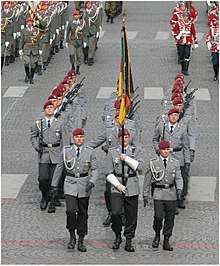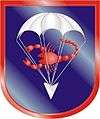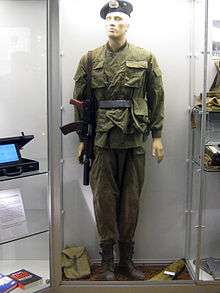Fallschirmjäger
Fallschirmjäger (German: [ˈfalʃɪʁmˌjɛːɡə] (![]()
German Fallschirmjäger in World War II were the first paratroopers to be committed in large-scale airborne operations. They came to be known as the "green devils" by the Allied forces they fought against.[1] The word Fallschirmjäger is from the German Fallschirm, "parachute", and Jäger, literally 'hunter,' which refers in this context to light infantry.
Nazi Germany (1935–45)

In the 1930s Hermann Göring, after having observed Soviet airborne infantry maneuvers, became committed to the creation of Germany's airborne infantry.[2][3] He ordered the formation of a specialist police unit in 1933, devoted to protecting Nazi party officials. The unit carried out conventional police duties for the next two years,[4] but in 1935, Göring transformed it into Germany's first dedicated airborne regiment.[4] The unit was incorporated into the newly formed Luftwaffe later that year and training commenced. Göring also ordered that a group of volunteers be drawn for parachute training. These volunteers would form a cadre for a future Fallschirmtruppe ("parachute troops").[4] In January 1936, 600 men and officers formed a Jäger and an engineer company.[5] Germany's parachute arm was officially inaugurated in 1936[6] with a call for recruits for a parachute training school. The school was open to Luftwaffe personnel, who were required to successfully complete six jumps in order to receive the Luftwaffe parachutist's badge.[6]
During World War II, the German Air Force (Luftwaffe) raised a variety of airborne light infantry (Fallschirmjäger) units. The Luftwaffe built up a division-sized unit of three Fallschirmjäger regiments plus supporting arms and air assets, known as the 7th Flieger Division. Throughout World War II, the Fallschirmjäger overall commander was Kurt Student.
Fallschirmjäger participated in the occupation of Norway and Denmark and in the battles of Belgium, the Netherlands and France in 1940. They also took part in the Balkans Campaign, Battle of Crete, Italian Campaign, and on both the Eastern Front and later the Western Front would follow.
Bundeswehr Fallschirmjäger (after 1945)


In the modern German Bundeswehr, Fallschirmjäger continue to form the core of special operations units. The division has two brigade equivalents and several independent companies and battalions. All told, about 10,000 troops served in that division in 2010, most of them support or logistics personnel. The division has the following structure:
- Special Operations Division
- Headquarters and Signal Company (stationed in Stadtallendorf) former time Battalion
- Army Band 300 (Koblenz)
.svg.png)

- Parachute Regiment 26 1./ Staff Support Companie 2./ 3./ Parachute-Commando 4./ 5./ 6./ Parachute Companies 7./ Parachute Heavy Weapon 8./ Parachut-Support 9./ Parachute-Medical 10./Reserve


- Parachute Regiment 31 1./ Staff Support Companie 2./ 3./ Parachute-Commando 4./ 5./ 6./ Parachute Companies 7./ Parachute Heavy Weapon 8./ Parachut-Support 9./ Parachute-Medical 10./Reserve
- Airborne Reconnaissance Company 310 (Seedorf)
- Airborne Engineer Company 270 (Seedorf)
- Special Forces Command (KSK) (Calw)
The vast majority of division members are deployable by parachute, and all of it is at least air mobile. Almost all vehicles and heavy equipment are transportable by helicopter, including special lightly armoured Wiesel heavy weapon transport vehicles adopted for this purpose. In addition to the Special Operations Division, Germany is also setting up an air mobile or air assault regiment.
former troops
- Airborne Air Defence Missile Battery 100 (Seedorf) - given out to Air Force
- Long Range Reconnaissance Training Company 200 (Pfullendorf) - Platoons in Airborne Reconnaissance Companies
.svg.png)
- Airborne Brigade 31 (Oldenburg) - both now Airborne Brigade 1



- Airborne Brigade 31 (Oldenburg)
- Headquarters Company (Oldenburg)
- Fallschirmjäger Battalion 313 (Seedorf)
- Fallschirmjäger Battalion 373 (Seedorf)
- Airborne Support Battalion 272 (Oldenburg, Seedorf)
National People's Army (East Germany)

40. Fallschirmjägerbataillon Willi Sänger was the only airborne infantry formation of the Nationale Volksarmee (NVA). The battalion and its airborne-commando school were based in Prora on Rügen (1961–82) and near Potsdam (1982–90). Officially, the battalion was an airborne unit organized as an NVA light infantry battalion, but in reality it was considered a commando unit. On mission, the companies of the battalion were to be split up into teams of five or six men. As a force with special capabilities, it remained under the direct command of the army high command (Kommando Landstreitkräfte, KdoLaSK).
The reconnaissance company of the Felix Dzerzhinsky Guards Regiment (German: Wachregiment "Feliks E. Dzierzynski"), an elite motorized rifle regiment of the Ministry for State Security of the German Democratic Republic (GDR), was a parachute-trained unit.
Bibliography
- Ailsby, Christopher (2000). Hitler's Sky Warriors: German Paratroopers in Action, 1939-1945. Staplehurst, UK: Spellmount Limited. ISBN 1-86227-109-7.
Bell, Kelly. "Costly Capture Of Crete." World War II 14.1 (1999): 50. MasterFILE Complete. Web. 22 Oct. 2014.
References